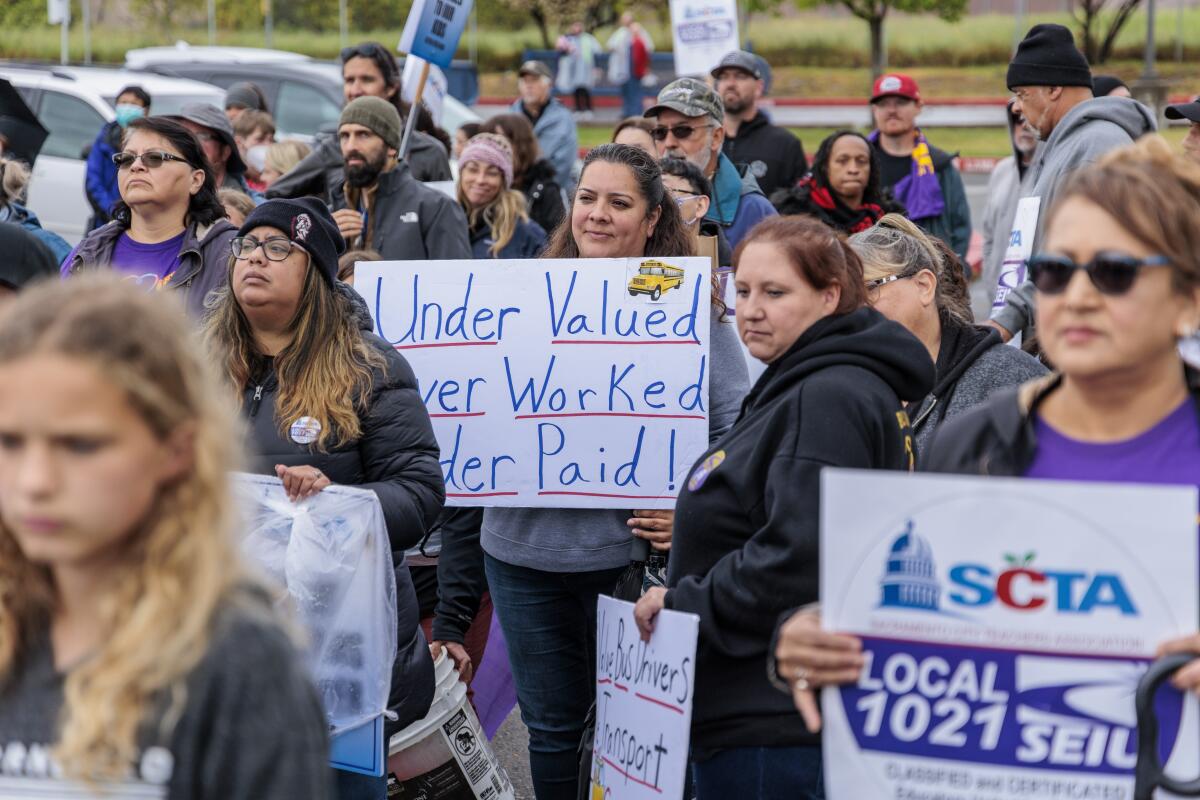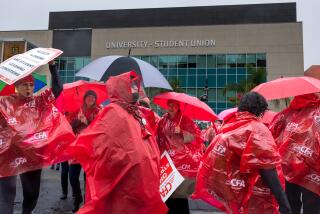Sacramento teachers’ strike ends, and schools reopen with tentative deal to increase salaries

- Share via
Schools reopened Monday in the Sacramento City Unified School District after teachers and other workers reached tentative agreements that increase pay and dole out one-time stipends, ending a crippling strike that has closed schools for eight days.
School district officials announced the tentative agreement Sunday night with the Sacramento City Teachers Assn. and SEIU Local 1021, a union representing bus drivers, instructional aides and custodians, and other classified staff.
The strike in California’s capital that began March 23 — affecting 43,000 students and 76 schools — was driven by what teachers and other district classified staff said were severe staffing shortages, heavy workloads and concerns over pay. The strike came as districts nationwide face similar crises exacerbated by the COVID-19 pandemic, including staff vacancies, exhaustion and the pressures of academic recovery.
The tentative agreement includes a 4% cost-of-living-increase pay adjustment, thousands of dollars in one-time stipends and improved dental and vision healthcare plans — changes that address the drivers of a classified staff shortage, the labor unions said. The agreement with the teachers union also includes a cost-of-living pay adjustment, one-time stipends, additional paid COVID-19 sick days and increased pay for substitute teachers and three additional days of professional development, among other stipulations.
Leading up to the strike, the district had hundreds of vacancies for educators and non-teaching classified staff, putting a strain on employees, union leaders said. Karla Faucett, president of SEIU Local 1021, said there are about 400 vacancies among classified staff — including bus drivers, cafeteria workers and school maintenance crews — that were exacerbated by static pay and a lack of benefits. Oftentimes, school staff take on other jobs to stay afloat or leave to another district offering more competitive pay. At one point, the bus driver shortage was so severe, teachers were driving students home, Faucett said.
The agreement gives raises to those among the lowest paid in the district and gives incentives to keep workers on the job and to help recruitment efforts, Faucett said. The district agreed to a $2,000 retention bonus for bus drivers next school year, as well as signing bonuses for new bus drivers. Improved vision benefits are among other new perks.
“There’s going to be a huge healing process,” she said. “We have a long way to go.”
For educators, the strike came at a critical time. About 100 teachers were planning to retire or resign next school year, a higher number than usual, said David Fisher, president of the Sacramento Teachers Assn. The district faced the possibility of as many as 400 teacher vacancies next school year. Before schools were shuttered for eight days during the strike, Fisher said that on average, thousands of students were going without regular instructors on a daily basis due to the lack of substitute teachers
“The doors were open but it wasn’t like what you would consider school,” Fisher said.
The tentative agreement calls for increased pay for substitute teachers and extra compensation to teachers working longer hours, Fisher said.
“‘Stop the bleeding’ was our first goal,” he said.
While the teacher union’s tentative agreement with the district will not “magically solve” the shortages, teachers will have more incentive to stay, including no cuts to health benefits.
The unions received support from the community, with some parents holding a sit-in outside the superintendent’s office during the strike to urge the superintendent and district into bargaining.
Sacramento City Unified Supt. Jorge A. Aguilar said in a statement that the agreements with the labor unions “demonstrate how highly we value our employees” returning to school on Monday. Aguilar also acknowledged the mass shooting over the weekend in Sacramento in a nightclub district where six people died and 12 others were wounded.
“Schools serve as safe havens and centers of emotional and mental health support for many students,” Aguilar said. “This tragedy underscores the importance of the return of our students and staff on Monday, and I look forward to welcoming our students back.”
More to Read
Sign up for Essential California
The most important California stories and recommendations in your inbox every morning.
You may occasionally receive promotional content from the Los Angeles Times.











